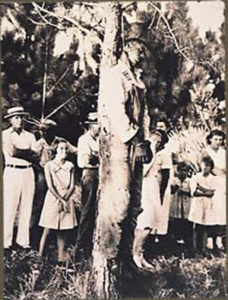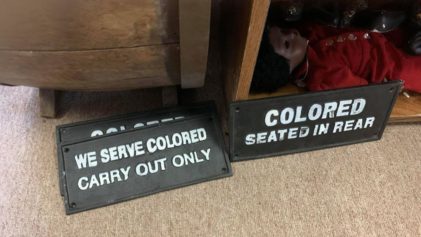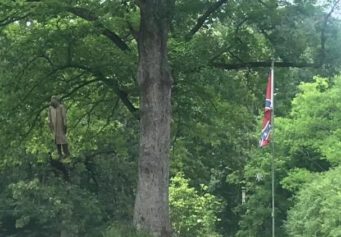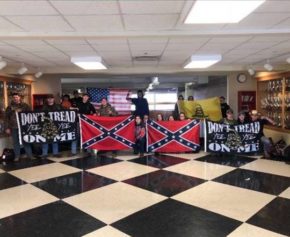
The lynching of Rubin Stacy. Onlookers, including four young girls. July 19, 1935, Fort Lauderdale, Florida.
The Confederate flag is a symbol of white privilege and segregation, the oppression of Black people, and the fight by Southern states to preserve slavery. But the flag also represents the peculiarly American brand of terrorism known as lynching.
While the South is strewn with Confederate flags and memorials that attempt to glorify a heritage of white supremacy and domestic terrorism, one civil rights lawyer wants to place memorials to lynching throughout the South. This is a glorious effort to reclaim the narrative of Southern history from the racists, and to set the record straight on the legacy of violence in the South. If the nation has any hope of coming to terms with this shameful past, it must acknowledge that it actually took place.
The Los Angeles Times reported that Bryan Stevenson, 55, a professor at NYU Law School and the head of the nonprofit organization the Equal Justice Initiative, plans to erect memorial markers where Black men, women and children were lynched. Sometimes people were hanged from telephone poles or from trees, for allegedly whistling at a white woman or sassing a white man, or demanding their rights, or for doing absolutely nothing at all.
The bronze markers will form a collective memorial, each marking the spot where the person was lynched.
In February 2015, EJI issued a report on lynching called “Lynching in America: Confronting the Legacy of Racial Terror,” in which the organization found that 3,959 people were lynched in the U.S. between 1877 and 1950—700 more than was previously known.
Georgia, Mississippi, Louisiana, Arkansas and Texas claimed the highest number of lynchings, while Florida, Mississippi, Arkansas and Louisiana had the highest rates of lynchings.
“Lynching profoundly impacted race relations in America and shaped the geographic, political, social, and economic conditions of African Americans in ways that are still evident today,” the report stated. “Terror lynchings fueled the mass migration of millions of black people from the South into urban ghettos in the North and West during the first half of the twentieth century. Lynching created a fearful environment where racial subordination and segregation was maintained with limited resistance for decades. Most critically, lynching reinforced a legacy of racial inequality that has never been adequately addressed in America.”
The report also concludes that the administration of criminal justice is inextricably linked to the history of lynching, a fact which compromises the fairness and integrity of the justice system. In making the case, the report explains that the imposition of the death penalty brought about a decline in the number of lynchings, representing a replacement of one form of state sanctioned violence with another, under the trappings and legitimacy of a judicial system. It is worth noting that 80 percent of lynchings took place in the Southern states, just as 80 percent of the executions over the past four decades have taken place in the former Confederacy.
Lynchings were acts of violence designed to maintain white dominance over Black people. Moreover, they were white Christian ritualistic killings, symbolic acts of violence not unlike the acts of terror that Americans would associate with groups such as ISIS or Al Qaeda. As the “other,” Black people served as the scapegoats whose deaths helped preserve the purity and hegemony of the white race. The practice of lynching reflects the power of the slave patrol and the lynch mob, the white judge and the all-white jury— the authority of white men to inflict collective punishment against Black people at will, sanctioned by the law. The psychic toll inflicted upon Black community has been great in terms of trauma caused by lynching.
Further, lynchings provided a form of public entertainment. Railroads ran excursions and sold tickets, and families had picnics to watch these spectacles. As Ida B. Wells said, the “nineteenth century lynching mob cuts off ears, toes, and fingers, strips off flesh, and distributes portions of the body as souvenirs among the crowd. If the leaders of the mob are so minded, coal-oil is poured over the body and the victim is then roasted to death.”
Without uttering the word, Billie Holiday sang about lynching in Abel Meeropol’s song “Strange Fruit,” capturing the inhumanity of racism.
Southern trees bear a strange fruit,
Blood on the leaves and blood at the root,
Black body swinging in the Southern breeze,
Strange fruit hanging from the poplar trees.Pastoral scene of the gallant South,
The bulging eyes and the twisted mouth,
Scent of magnolia sweet and fresh,
And the sudden smell of burning flesh!Here is a fruit for the crows to pluck,
For the rain to gather, for the wind to suck,
For the sun to rot, for a tree to drop,
Here is a strange and bitter crop.
Meanwhile, at a time when the Confederate flag, Black church massacres and Black church burnings are coming into full view—and Black bodies are taken from us through police and vigilante violence—the timing of this lynching memorial project could not be better.


